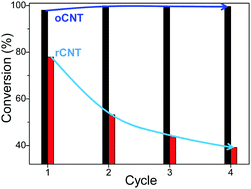The durability of carbon nanotubes in the selective reduction of nitrobenzene†
Abstract
Surface oxidized carbon nanotubes (oCNTs) were quite stable for the selective reduction of nitrobenzene, while notable deactivation was observed for the un-oxidized sample (rCNTs). The adsorption of N-containing compounds had a negligible effect, but the formation of a carboxyl group and anhydride was mainly responsible for the deactivation of rCNTs.



 Please wait while we load your content...
Please wait while we load your content...